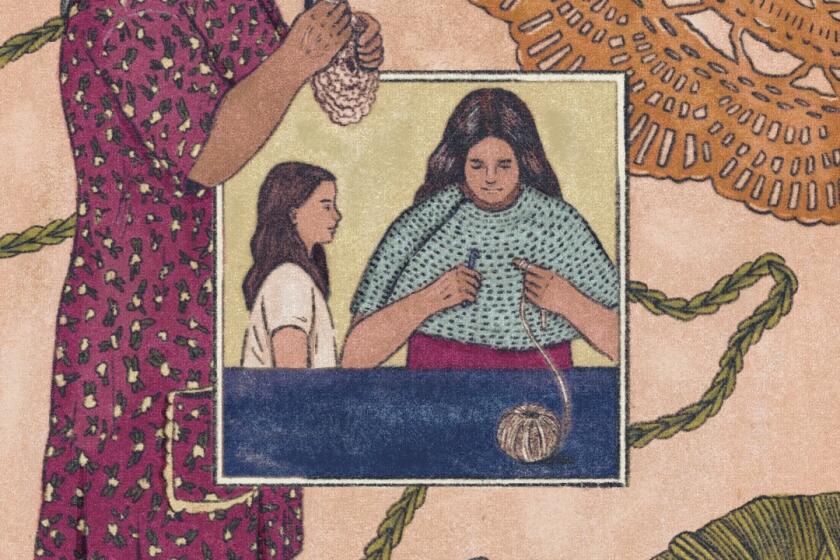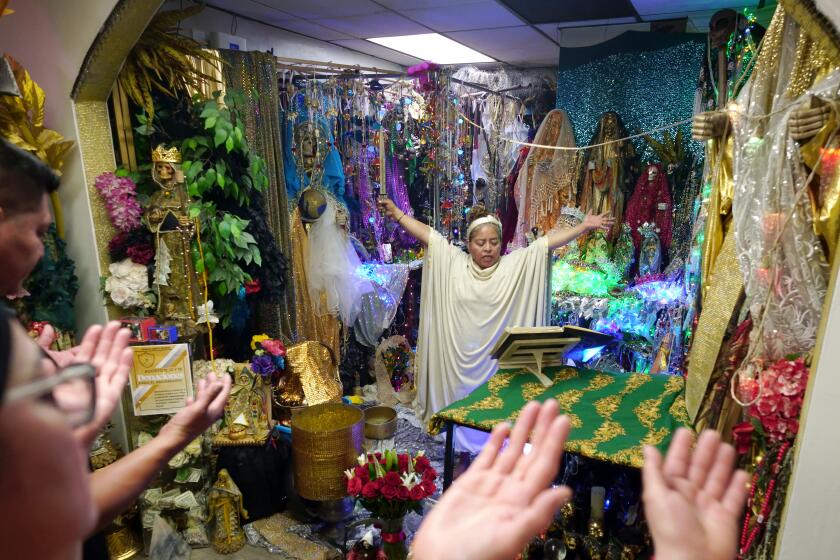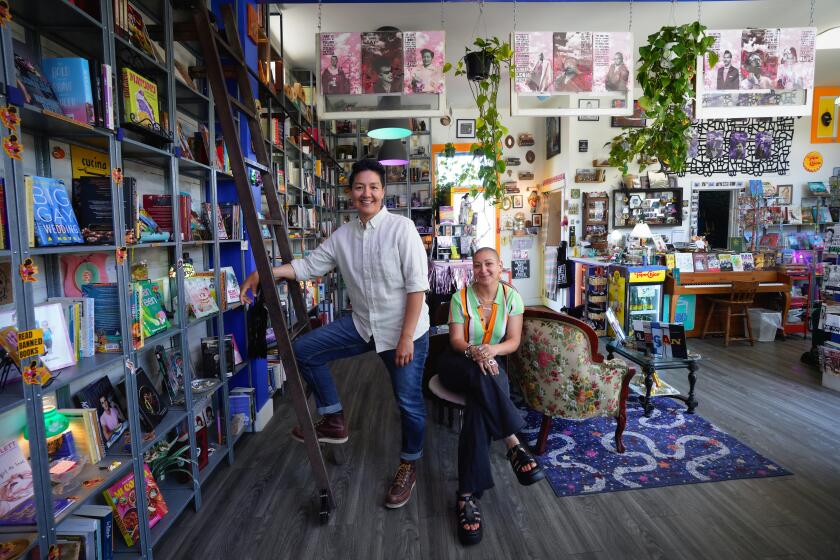
- Share via
My eyelids felt like they weighed 500 pounds, but I managed to open them as I was coming back to consciousness. Everything was blurry, until I saw the number “2” marked on my hand in black Sharpie, indicating the number of eggs my doctor had been able to retrieve from my body after weeks of expensive hormone injections, mood swings and the emotional toll of time being against you.
Two was not the number I’d hoped for. Two meant more injections, more money and more weeping in public places. My world came into a sharp focus at that moment in the most heartbreaking way, but I also thought the “2” would make a pretty cool tattoo.
Latinx women, and other birthing individuals, who are 35 or older and going through the fertility process deeply understand the price of time and the deeper cultural pressure that comes with it.
Lizy Wildsmith, a research scholar at Child Trends, a nonpartisan research organization focused on improving the lives of children and youths, studies reproductive health and family formation with a particular focus on the Latinx community.
“Fertility rates have increased among women aged 35 and older for several decades now. This is true also among Hispanic women,” Wildsmith said.
With the help of Latina therapists, first-generation women are laying down boundaries and addressing unhealthy family dynamics, but it can sometimes feel like thankless work.
Wildsmith says the average age of Latinx people giving birth for the first time is 25.5, but as of 2021, about 20% of all births were among people age 35 and older, with that rate resting at 17% for Latinx women of the same age group.
While most births to Latinx women age 35 and older are second or third births, Wildsmith says, 16.7% are first births, also marking an increase. Just under 1% of births to Latinx women were from a pregnancy resulting from infertility treatment. Compare that with white non-Latinx women, who become pregnant through infertility treatments at a rate of 3%.
“It’s still a pretty small percentage of births overall, even in those age groups,” Wildsmith said. “But it’s been increasing a lot.”
More and more Latinx people are choosing to wait to have children for a variety of reasons, including but not limited to the astronomical cost of raising a child, a desire to accomplish more for themselves first, the disproportionately larger effects parenthood has on women’s lives and careers, cost of living overall, and the frightening realities of bringing a child into this world.
However, waiting means greater issues with fertility. At age 30, fertility rates begin to decline; by 45 the likelihood of getting pregnant naturally is extremely low. As a result, many in their 30s turn to fertility treatments to help them build their families.
“I wasn’t ever anybody who was like, ‘I must have a kid or my life will be incomplete.’ I never felt that way,” said Dayna Cobarrubias, a 43-year-old entertainment executive in West Hollywood who began her fertility journey at 35. “But once I felt that there was a possibility that it actually wasn’t an option, I was really sad about that. So I felt more [urgency] about figuring it out.”
The R&B themed yoga classes might suggest added choreographed routines to newcomers, and while it includes an occasional twerk and body roll, yoga and its meditative elements take precedence.
So when her struggles with fertility came, it hit Cobarrubias harder than expected, giving her a slight crisis of identity.
“There’s this trope or stereotype of Latinas being super fertile. Then when you’re not or when you come up against challenges with that, you’re like, ‘Am I really Latina?’” she said. “I remember thinking like, ‘Oh, this is ironic.’”
For those wishing to get pregnant, waiting could be a result of wanting to break generational cycles of poverty, societal expectations or trauma. For first-gen individuals, many of these factors are based on building from the sacrifices of their immigrant parents.
Rocio M., who asked that only her first name be used for professional reasons, is a college professor living in Highland Park. At 40, she is pregnant with her first child after going through an often “traumatic” fertility process using intrauterine insemination, or IUI, treatments, otherwise known as artificial insemination.
She recalls going to reproductive health clinics with friends in high school. She had friends who became mothers in high school, and it was her hope to avoid that fate, especially considering the stigmas and stereotypes around Latinx teen girls, who have had the youngest birthing rates in the country.
The Virgen de Guadalupe is a symbol of Mexican resistance but also one of colonization and the Catholic Church.
Rocio went to grad school, and once she built a career and got her student loans in order, she felt ready for parenthood. In her 30s, she met the woman who would become her wife.
“I think finding a person that I feel like I can do this with is what gave me the ánimo to do it,” Rocio said.
Rocio went into the process optimistically. Although she was 39 at the time, she’d had a pregnancy in her late 20s that she chose to terminate.
“In my mind, I’m like, ‘I have conceived. I can do this again,’” she said.
Toxic gratitude or ‘Si Dios Quiere Syndrome’ is the concept that Latinos are too content with just receiving scraps instead of demanding what they deserve.
Once the results of various tests came back, however, Rocio realized conceiving may be harder than expected.
“That’s when it started to sink in that I’m not as fertile as I thought,” she said. “I kept thinking my body betrayed me. I’m like, ‘I thought we were good. You were running half-marathons. You’ve conceived before.’”
Rocio weighs her fears as a teenager to the difficulties she has faced in conceiving later in life.
“Here you are on the other side, where you’re just like, ‘Goddamn now I know I’m ready and we can’t have it,’” she said.
For Chicanos in particular, the sweet treat has become a mascot. But what is it about the concha that has elicited such fanfare?
Like Cobarrubias, Rocio and the three other women I spoke to, I wanted to wait for my career to be in order, and I wanted to feel as ready as possible. At 36, I was still out most nights, drinking and smoking cigarettes, dating unseriously and working 10-hour days. I wasn’t ready for the full responsibility of having a baby.
Then I got pregnant and had a miscarriage. That put a lot into perspective with regard to my work and whom I chose to build a family with — a family that I really did want to have someday.
I’ve seen plenty of women in my life parent on their own, even when they had husbands, and I looked at every potential life partner with that in mind. I wanted a loving, supportive partner and a family, but not at the cost of everything I built for myself.
That meant lying with my legs in the air a couple of years later while a doctor scooped out some eggs from my huevo warehouse to put them to freeze.
It wasn’t my first go-around with egg freezing. A few years ago, I had started the process in New York, but the experience was so deeply unsettling I backed out after my initial consultation. After retrieving only two eggs earlier this year during my first full cycle of egg freezing, I was angry at myself for not finding another doctor back then when the number could’ve been 10 or 20.
With every stitch, every loop and every turn of the hook, I carry the legacy of my great-grandmother and my mom, as well as the cultural history of Mexico.
Now, I’ve been trying to buy time, feeling like my eggs are on the clearance rack. I had to find a third, new doctor because my experience with the last one left me feeling hopeless and with zero sense of my options, which is important because fertility treatments are invasive and massively expensive.
On average, a single round of in vitro fertilization treatments, including egg freezing and embryo freezing, cost $15,000 to $30,000. Twenty-one states have passed fertility insurance coverage laws, according to Resolve, the National Infertility Assn., but only 14 include IVF coverage.
In California, the law does not require insurers to cover IVF, and employers can choose whether they want to include infertility coverage as part of their health benefits package. Most people needing fertility treatments have to go through a private clinic and pay out of pocket. It’s become a hugely lucrative business, for better or worse.
So far, the cost of one of my IVF cycles has been $13,577, and my new doctor quoted me a little under $23,000 for a new cycle, this time for embryo freezing. I’m beyond lucky, however, because my union (which provides my insurance) offers full coverage through a fund that caps at $30,000.
Rocio and her wife weighed their financial options when they began to plan for a baby, especially when faced with the possibility of losing more time.
“We’d much rather just take out the loan or charge it or something versus waiting,” Rocio said. “We had to have heart-to-heart conversations about how far we want to go. Like, how much money are we willing to spend?”
‘People are just not feeling accepted within that box that the Catholic Church is desperately holding on to.’
For Rocio and her wife, that was $8,700 out of pocket for her IUI treatments and some alternative treatments, with the rest being covered by insurance. She’s now pregnant and due in late November.
Cobarrubias invested $20,000, all out of pocket.
Rocio and Cobarrubias have seen multiple doctors after having bad experiences with previous specialists, leading to more costs. Taking out large loans or racking up credit card debt is the reality for many people going through treatments, but others have chosen another option.
Anel Bravo is a 35-year-old employee of the California Department of Education in Sacramento who is currently in an IVF cycle. School and work, followed by the COVID-19 pandemic, delayed Bravo and her husband’s plans to get married and start a family. But in 2021, they were able to start both journeys.
“We tried for over six months,” Bravo said. “It wasn’t happening for us, and I kind of had a feeling that something was up with me.”
“We went to a clinic here in Sacramento and I didn’t really like it, and then the cost,” said Bravo, who was quoted in the $30,000 range for treatments. “It’s really overwhelming to see that price tag. And so my husband and I, after discussing it, we actually decided to go to Tijuana [for fertility treatments] and so that’s where I’m at now.”
The co-host of ‘Drag Race Mexico’ sat down with columnist Suzy Exposito to discuss her illustrious television career, her Chicana pride and the freedom of being nonbinary.
Bravo, often on her own, flies from Sacramento to her parents’ home in the Inland Empire, then drives to Tijuana for fertility treatments, where she says the standard of care has been much better than she’s received in the U.S. Sometimes, she’s down there for as long as a month, but it’s worth it to her. At the clinic where she is being treated now, Bravo is being charged $12,000 for four cycles of IVF, with a money-back guarantee if she doesn’t get pregnant.
“It’s a huge amount of money and thankfully my husband and I were able to afford it, but this is not something that’s accessible to just anybody,” Bravo said. “[The price is] a huge barrier. So we saved a significant amount of money by going to Tijuana. Even with all of the traveling and being away from home for so long, I would still do it.”
When it comes to fertility and family planning, there’s little information provided in a person’s life. Our bodies become odd mysteries, and we’re attempting to work within a healthcare system that often makes it impossible to unravel.
For Valeria Moran, a 42-year-old dental hygienist from Chula Vista, Calif., who, along with her husband, began her fertility journey when she was 35. It was not a matter of her eggs but rather issues with her husband’s sperm morphology. His sperm was discovered to have malformations, like two heads, that made natural conception and several rounds of IUI treatments unsuccessful. This discovery was unpredictable and further proof of how little we know about our bodies and conception. After weighing their choices, Moran and her husband decided to adopt, and now have a son.
Latino-run shows sometimes perpetuate stereotypes we would criticize in other shows. And some non-Latino shows do a better job of telling our stories than Latino-run shows
Every person I spoke to experienced coldness, avoidance, confusion and trauma while going through the process. Some even felt gaslighted. They tried new doctors or alternative fertility treatments in hopes of getting help and clarity.
In my most recent appointment with a new fertility specialist, she explained everything, including all my options and what the most cost-effective choice would be, in clear, simple language. I finally felt empowered and like I understood my body, so much so that I cried at her desk from relief.
I could finally breathe because I was no longer navigating in darkness. I’m lucky that I have the tools and means to find this doctor, research their credentials, and pay the $822 fee for my first visit. That is not accessible to most people. And in the Latinx community, shame and secrecy around sex, conception and women’s bodies are still pervasive, adding another barrier to seeking care.
“I just feel like it’s not something that’s ever really talked about, especially in the Latino community,” Cobarrubias said. “It’s kind of the opposite, like the traditional narratives are more focused on motherhood as opposed to the challenges of infertility or nontraditional approaches to motherhood.”
This reality often leads people going through fertility treatments to do so in secret because of the responses or questions that will come from their families.
“Public narratives about Latinos’ economic condition place far too much emphasis on individual behaviors of the group, rather than structural factors such as discrimination.”
When I told my mom I was struggling with my fertility, the first thing she said was “te dije.” I should’ve had a baby with any one of my exes, including the extra bad one, or with “cualquier fulano.” It was a frustrating, but not surprising, reaction considering her thirst for an 11th grandchild and her dedication to a bit at all costs. It led to several lengthy conversations with her about why it was hurtful and problematic.
Similarly, Bravo has chosen not to tell her extended family, especially when they’ve asked why she and her husband haven’t had kids yet.
“For people who are going through this infertility journey, it’s very painful,” she said. “So having to rehash like, ‘I can’t really have kids the way that everybody else does,’ feels very vulnerable. And that’s not something that you’re trying to have a conversation about at your cousin’s baptism. … I don’t have the energy. You have to field really dumb comments, even well-intentioned ones. ”
Imagine now if someone who may or may not want to conceive a baby someday could know, early on, what their fertility looks like. What if at every routine checkup starting as early as 20 or 25, you could also be offered a wellness check on your egg reserve fertility so that you can consider your future plans? That’s one thing Cobarrubias hopes for in the future.
“Something that’s optional for you to assess what your readiness levels are,” she said. “And if you need to do anything to adapt your routine, if you plan to conceive or freeze eggs in the next several years. I just wish there was something that was offered. Even if I don’t want to do it now, there’s things you need to do in advance.”
‘When I first started playing folk music, people would look at my cowboy boots and be like, “Wow… so how did that happen?” ’
One company, Modern Fertility, offers at-home fertility tests that provide information about your hormones and fertility at a fraction of the cost.
It was this test that informed Daisy Osorio-Velazquez, a 26-year-old education coordinator at a nonprofit who lives in Fullerton with her husband, that she had hormone levels that indicated she had a low ovarian reserve and could be premenopausal, meaning her ability to have children was extremely narrow.
Osorio-Velazquez’s world and her future changed in an instant. When she began to seek help from doctors, she says, she was dismissed, and realized the emotional and financial toll that treatment would require.
“When I took the test, I was just intending to be preventative,” she said. “I grew up in a low-income household. My family life at home when I was little was not stable. I knew I always wanted to have kids, but I was hoping we could be in a better financial position. I hoped to be able to provide my kid with certain opportunities that my mom wasn’t able to provide me growing up. … I just felt like time was stolen.”
Osorio-Velazquez and her husband are looking at their options in the U.S. and Tijuana while attempting to save enough money to enable them to undergo treatments. Even through her heartbreak, she’s thankful to have learned early on about her fertility issues as opposed to at 35 or older when ostensibly it would’ve been too late. As a result, she’s become an advocate within her community for spreading awareness of infertility and preventive care.
When Jesi Gutierrez and Celi Hernandez opened their shop in San Diego, they wanted to create a space where all writers and artists felt comfortable being themselves.
For a country that so wants women to have children, even by force, there’s little done to ensure those who want to conceive can access proper fertility care at an affordable price in a fully supportive environment.
As I continue my own journey, the hardship and unfairness of the process weigh on me, but it’s my hope that through talking about the experience openly with one another and within our communities, and allowing ourselves to laugh when we can, the process can be easier to navigate.
“You try to find little moments of joy and laughter. But then it just feels crazy because you’re just like ‘What the f— is happening,’” Bravo said. “You just hope, and you do everything you can.”
Alex Zaragoza is a television writer and journalist covering culture and identity. Her work has appeared in Vice, NPR, O Magazine and Rolling Stone. She’s written on the series “Primo” and “Lopez v. Lopez.” She writes weekly for De Los.
More to Read
The Latinx experience chronicled
Get the Latinx Files newsletter for stories that capture the multitudes within our communities.
You may occasionally receive promotional content from the Los Angeles Times.


















